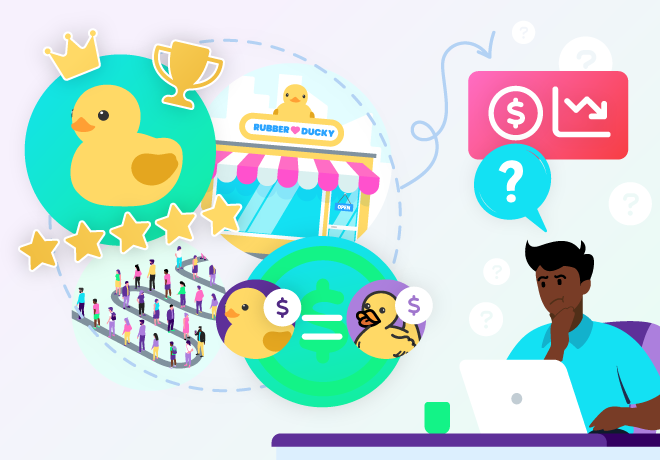
How to craft your eLearning courses from instructor-led content
Transforming your instructor-led classes into online courses can be daunting. Transferring a fully developed classroom session into eLearning involves adjustments in how you approach your learners and the material of the course. But as the world increasingly transitions to remote work and online environments, this task will become less of a luxury and more of a necessity.
Following these best practices will take your instructor-led content to the next level online.
Step 1: Define objectives and trim content

The first step in transferring your instructor-led classes into online courses is capturing the content. You may have complete speaker’s notes but, if not, try recording a live session. The transcript pulled from this session should be the bulk of the information you want to use for the course. Make this task easier by using AI tools to help you compile and edit the transcript.
Once you have your transcript from the course, ask yourself:
- What information do learners need to know to meet the objective(s)?
- What is the primary, secondary, and “nice-to-know” information?
- What skills do learners need to perform to meet the objective(s)?
With these questions in mind, start by cutting out any side conversations or information that doesn’t serve the central objective(s) of the course. These conversations can be confusing for a learner who doesn’t have the full context of the discussion.
As well, information that distracts from the objective(s) of the course can cause a learner to not pay attention to other portions that are of use to them.
Step 2: Transform presentation into coherent lessons
After removing any unnecessary banter and/or information, the transcript of an instructor-led course will generally look like big blocks of text, with few breaks in the information.
It’s important to remember that the audible cues in an instructor-led classroom are difficult to convey in an online environment. Without the instructor’s flair, long stories and anecdotes that are engaging to an auditorium audience can feel like an annoyance for an online learner.
Presenting large chunks of text to learners can dampen any motivation they have to learn the material. Scanning text that’s in smaller pieces makes it easier for learners to look at and absorb the information.
For example, these two blocks of text contain the exact same information. Which one are you visually drawn to?
While the second block of text may look longer, it’s actually the same information but it’s visually easier to scan and consume the information. Learners are drawn to information that is clear and easy to read.
A few questions to consider while you’re reshaping text blocks:
- Can I break these separate thoughts into different paragraphs?
- Can I create a list out of multiple items that relate a single point?
- Can I break this run-on sentence up into two sentences?
- Does this sentence even add value to the learner?
Step 3: Restructure and simplify sentences
Restructuring and simplifying sentences can often be an overlooked step in transitioning instructor-led training into online friendly content.
When presenting information online, you’re working within a limited space (i.e., screen sizes) and getting to the point faster helps save space for other important information.
Simplifying the structure of a sentence follows a four-step process:
- Identify the central point of a sentence.
- Trim any unnecessary connecting words and phrases (as well as, in regards to, furthermore, etc.)
- Read the sentence from a learner’s perspective.
- Repeat until satisfied.
Remember that there’s a fine balance between simplifying and over-simplifying. Adults still enjoy language that is nuanced and don’t want to be pandered to while learning new information.
Understanding your audience will help you tailor your content to their specific needs.
Step 4: Edit for consistency

Once you’ve trimmed down to the most important material, adjusted your content layouts, and restructured your sentences, the last step in putting it all together is checking for consistency.
When writing a script for instructor-led training, the consistency of the material is related to ensuring that the objective(s) of the course are met. Spelling mistakes and grammar aren’t as important as long as the central message is still consistent. In ILT, learners won’t see these types of inconsistencies.
Consistency in an eLearning course relates to aspects like the use of regionally specific spelling, grammar, tone & voice, and the overall message of the material. Learners will see these types of consistencies and there should be absolute consistency in an eLearning course.
When checking for consistency, you should ensure that:
- Everything is spelled correctly
- All of your sentences are grammatically correct
- The same regionally specific spelling is used throughout the course (e.g., color/colour, gray/grey, defence/defense, etc.)
- The same tone & voice are used throughout (i.e., use active voice throughout, use the same tense and person throughout the slide, etc.)
- All the material is related to a specific section or the central objective(s) of the course (e.g., don’t use a baseball quote in a hockey fundamentals course, don’t discuss advanced techniques part-way through a fundamentals slide, etc.)
Once you've got your content down, you can build eLearning storyboards, look into adding interactivities, and create ways of testing your learners’ knowledge throughout the course.
Making your content objective-based, easily read, well structured, and consistent will help improve information retention. Learning will come naturally if your content feels easy to navigate!
Learning Hub: free resources for eLearning
The Neovation Learning Hub contains many free resources and articles that can help you improve eLearning outcomes at your organization. Continue learning about Custom eLearning Development topics, read articles on Instructional Design, or find new eLearning tools to help you with your eLearning initiatives.





-svg.svg)
-svg.svg)
-svg.svg)
-svg.svg)